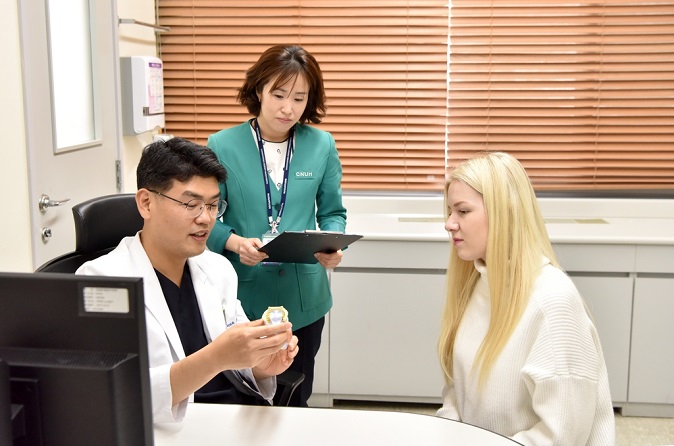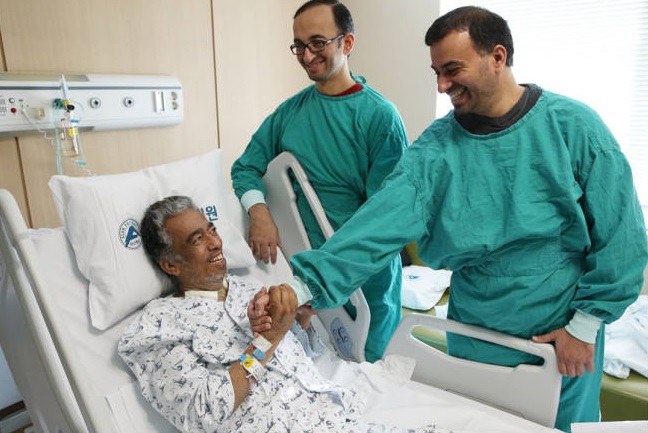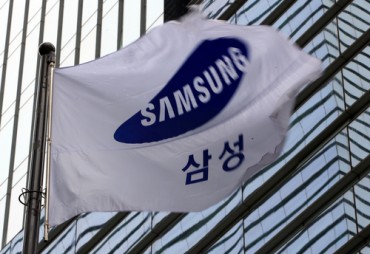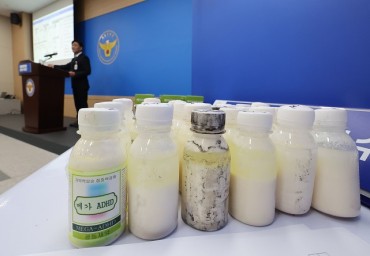
A doctor is treating a foreign patient in this photo provided by Chonnam National University Hwasun Hospital.
SEOUL, May 30 (Korea Bizwire) — The Ministry of Health and Welfare, in conjunction with related ministries, unveiled the “Strategy to Revitalize Attraction of Foreign Patients” on Monday.
The strategy aims to bolster Korea’s appeal as a premier medical destination.
Building upon the impressive influx of foreign patients in recent years, with 248,000 visitors recorded last year — an astounding 70 percent increase from 2021 (146,000) and a significant recovery towards pre-pandemic levels in 2019 (497,000) — the government has set an ambitious target of achieving an annual growth rate of 26 percent, ultimately attracting 700,000 foreign patients by 2027.
To accomplish this goal, the government has devised four key strategies spanning various sectors.
These encompass enhancing immigration procedures, mitigating the concentration of medical specialties in specific regions, strengthening the competitiveness of host industries, and raising global awareness of South Korea’s exceptional medical capabilities.
A pivotal aspect of the plan involves expanding the number of host organizations authorized to apply for e-visas issued by the Ministry of Justice, with the aim of increasing the current count from 27 to over 50 this year.
This expansion will facilitate online visa issuance, eliminating the need for foreign patients to visit overseas diplomatic missions.
Additionally, the plan emphasizes broadening the scope of caregivers and guardians to include siblings of foreign patients, alleviating them from the requirement to submit proof of financial capacity.
However, the health ministry acknowledges concerns regarding potential non-medical entry and illegal immigration resulting from the relaxation of visa issuance.
Consequently, relevant ministries will engage in discussions to develop appropriate preventative measures.
In order to seamlessly integrate medical care and tourism, the government plans to establish wellness medical tourism convergence clusters in strategic locations including Incheon, Daegu-North Gyeongsang Province, Busan, Gangwon Province, North Jeolla and North Chungcheong provinces,
These clusters will offer foreign patients and their caregivers the opportunity to combine medical treatment with sightseeing, such as visits to hot springs.

A foreign patient admitted to Asan Medical Center is reuniting with his relatives after finishing his treatment in this photo provided by the hospital.
By addressing the prevailing concentration of 70 to 80 percent of foreign patients in the Seoul metropolitan area, this strategy aims to mitigate regional disparities.
Furthermore, the government aims to explore and promote tailored medical and tourism models catering to VIP patients and long-term residents.
Additionally, promotional marketing efforts will capitalize on the allure of “K-culture,” encompassing Korean music and dramas.
Expanding beyond plastic surgery and dermatology, the infrastructure designed to attract foreign patients will include treatment for severe and complex diseases, such as cancer treatment and transplantation, which require advanced medical technology and expertise in Korean medicine.
Harnessing the potential of information and communications technology, the government aims to extend remote pre-consultation and follow-up management services for foreign patients.
Furthermore, concerted efforts will be made to institutionalize non-face-to-face treatment by revising the Medical Overseas Expansion Act in collaboration with the Medical Act.
The government’s initial step in this direction involves conducting a comprehensive study on the country’s licensing system for treating foreign patients abroad, deliberating the potential approval of non-face-to-face medical treatment.
To enhance awareness of Korean medical care, the government intends to foster collaboration between the public and private sectors, actively participate in international events, and leverage online platforms.
Ashley Song (ashley@koreabizwire.com)






